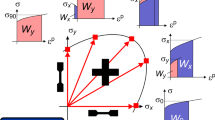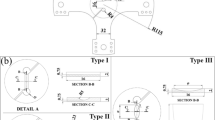Abstract
In this paper, the forming limit curve (FLC) of AA5754-O was predicted numerically through simulating the M-K approach with the consideration of initial groove orientation and investigated experimentally through the biaxial tensile tests. Firstly, the uniaxial tensile test and the equi-biaxial tensile test were performed to determine the mechanical properties and the anisotropic coefficients of Yld2000-2d yield criterion. Secondly, the numerical M-K approach considering the initial groove orientation and Yld2000-2d yield function was simulated to study the effects of the initial groove orientation and the imperfection coefficient on the predicted limit major strain. Finally, the shape of the cruciform specimen thinned at the center region was optimized for reducing the shear stress, and the optimized cruciform specimen was stretched under different loading paths to determine the experimental limit strains. Through comparing the predicted limit strain at uniaxial tensile stress state and the experimental one, the imperfection coefficient was confirmed, and a good agreement between the numerical result and experimental data was presented. This work showed that experimentally determining the limit strains through biaxial tensile test was achievable, and the proposed numerical M-K approach was effective for predicting the limit strains.
Similar content being viewed by others
References
Gensamer M (1946) Strength and ductility. Trans ASM 36:30–60
Keeler SP, Backofen WA (1963) Plastic instability and fracture in sheets stretched over rigid punches. ASM TRANS Q 56(1):25–48
Valente Tigrinho LM, Chemin Filho RA, Prestes Marcondes PV (2013) Fracture analysis approach of DP600 steel when subjected to different stress/strain states during deformation. Int J Adv Manuf Technol 69:1017–1024
Hajian M, Assempour A (2014) Experimental and numerical determination of forming limit diagram for 1010 steel sheet: a crystal plasticity approach. Int J Adv Manuf Technol 76:1757–1767
Mitukiewicz G, Anantheshwara K, Zhou G, Mishra RK, Jain MK (2014) A new method of determining forming limit diagram for sheet materials by gas blow forming. J Mater Process Technol 214:2960–2970
Rocha ABD, Barlat F, Jalinier JM (1985) Prediction of the forming limit diagrams of anisotropic sheets in linear and non-linear loading. Mater Sci Eng 68:151–164
Yang L, Hu G, Liu J (2015) Investigation of forming limit diagram for tube hydroforming considering effect of changing strain path. Int J Adv Manuf Technol 79:793–803
Shiratori E, Ikegami K (1967) A new biaxial tension testing machine with flat specimens. J Soc Mater Sci Jpn 16:433–439
Lei Y, Huang S, Meng Z, Hu J, Zhou M (2017) Effects of biaxial tensile on the deformation behavior of DP590 high-strength steel sheet under high strain rate. J of Wuhan University of Technology-Mater Sci Ed 32:1441–1445
Ozturk F, Pekel H, Halkaci HS (2011) The effect of strain-rate sensitivity on formability of AA 5754-O at cold and warm temperatures. J Mater Eng Perform 20(1):77–81
Ma X, Li F, Li J, Wang Q, Yuan Z, Fang Y (2015) Analysis of forming limits based on a new ductile damage criterion in St14 steel sheets. Mater Des 68:134–145
Zhalehfar F, Hashemi R, Hosseinipour SJ (2014) Experimental and theoretical investigation of strain path change effect on forming limit diagram of AA5083. Int J Adv Manuf Technol 76:1343–1352
Fatemi A, Mollaei Dariani B (2015) Forming limit prediction of anisotropic material subjected to normal and through thickness shear stresses using a modified M–K model. Int J Adv Manuf Technol 80:1497–1509
Cunsheng Zhang LL (2010) A methodology for evaluating sheet formability combining the tensile test with the M-K model. Mater Sci Eng A 528:480–485
D. Banabic, O. Cazacu, L. Paraianu, P. Jurco (2005) Proceedings of the 6th International Conference and Workshop on Numerical Simulation of 3D Sheet Metal Forming Process. MI, USA 778:466–471
Guo X, Gu Y, Wang H, Jin K, Tao J (2017) The Bauschinger effect and mechanical properties of AA5754 aluminum alloy in incremental forming process. Int J Adv Manuf Technol 94:1387–1396
Zhang S, Leotoing L, Guines D, Thuillier S, Zang SL (2014) Calibration of anisotropic yield criterion with conventional tests or biaxial test. Int J Mech Sci 85:142–151
Mánik T, Holmedal B, Hopperstad OS (2015) Strain-path change induced transients in flow stress, work hardening and r-values in aluminum. Int J Plast 69:1–20
Barroso A, Correa E, Freire J, París F (2017) A device for biaxial testing in uniaxial machines. Design, manufacturing and experimental results using cruciform specimens of composite materials. Exp Mech 58:49–53
Hannon A, Tiernan P (2008) A review of planar biaxial tensile test systems for sheet metal. Int J Mater Prod Technol 198:1–13
Li G, Xu F, Sun G, Li Q (2014) Identification of mechanical properties of the weld line by combining 3D digital image correlation with inverse modeling procedure. Int J Adv Manuf Technol 74:893–905
Wu XD, Wan M, Han F, Wang HB (2006) Stress-strain curves for different loading paths and yield loci of aluminum alloy sheets. Trans Nonferrous Metals Soc China 16:1460–1464
Barlat F, Brem JC, Yoon JW, Chung K, Dick RE, Lege DJ, Pourboghrat F, Choi SH, Chu E (2003) Plane stress yield function for aluminum alloy sheets—part 1: theory. Int J Plast 19:1297–1319
Kuwabara T, Ikeda S, Kuroda K (1998) Measurement and analysis of differential work hardening in cold-rolled steel sheet under biaxial tension. J Mater Process Technol 80–81:517–523
Li X, Song N, Guo G, Sun Z (2013) Prediction of forming limit curve (FLC) for Al–Li alloy 2198-T3 sheet using different yield functions. Chin J Aeronaut 26:1317–1323
Cai Z, Diao K, Wu X, Wan M (2016) Constitutive modeling of evolving plasticity in high strength steel sheets. Int J Mech Sci 107:43–57
Wang H, Yan Y, Han F, Wan M (2017) Experimental and theoretical investigations of the forming limit of 5754O aluminum alloy sheet under different combined loading paths. Int J Mech Sci 133:147–166
Seymen Y, Güler B, Efe M (2016) Large strain and small-scale biaxial testing of sheet metals. Exp Mech 56:1519–1530
T. Kuwabara (2014) 1.06 – Biaxial stress testing methods for sheet metals, In Compr Matals Process 1:95–111
Xiao R, Li XX, Lang LH, Song Q, Liu KN (2017) Forming limit in thermal cruciform biaxial tensile testing of titanium alloy. Int J Mater Prod Technol 240:354–361
Makris A, Vandenbergh T, Ramault C, Van Hemelrijck D, Lamkanfi E, Van Paepegem W (2010) Shape optimisation of a biaxially loaded cruciform specimen. Polym Test 29:216–223
Hu JJ, Chen GW, Liu YC, Hsu SS (2013) Influence of specimen geometry on the estimation of the planar biaxial mechanical properties of cruciform specimens. Exp Mech 54:615–631
Palumbo G, Tricarico L (2007) Numerical and experimental investigations on the warm deep drawing process of circular aluminum alloy specimens. J Mater Process Technol 184:115–123
Abedrabbo N, Pourboghrat F, Carsley J (2007) Forming of AA5182-O and AA5754-O at elevated temperatures using coupled thermo-mechanical finite element models. Int J Plast 23:841–875
Wang HB, Wan M, Yu Y (2012) Effect of flow stress—strain relation on forming limit of 5754O aluminum alloy. T Nonferrous Metals Soc 22:2370–2378
Acknowledgements
The authors would like to give thanks for the financial supports from the National Nature Science Foundation of China (Nos. 51635005 and 51605018) and the China Postdoctoral Science Foundation (No. 2018M630058). Furthermore, the helpful comments from the reviewers are also appreciated.
Author information
Authors and Affiliations
Corresponding author
Rights and permissions
About this article
Cite this article
Yuan, W.N., Wan, M., Wu, X.D. et al. A numerical M-K approach for predicting the forming limits of material AA5754-O. Int J Adv Manuf Technol 98, 811–825 (2018). https://doi.org/10.1007/s00170-018-2332-z
Received:
Accepted:
Published:
Issue Date:
DOI: https://doi.org/10.1007/s00170-018-2332-z




